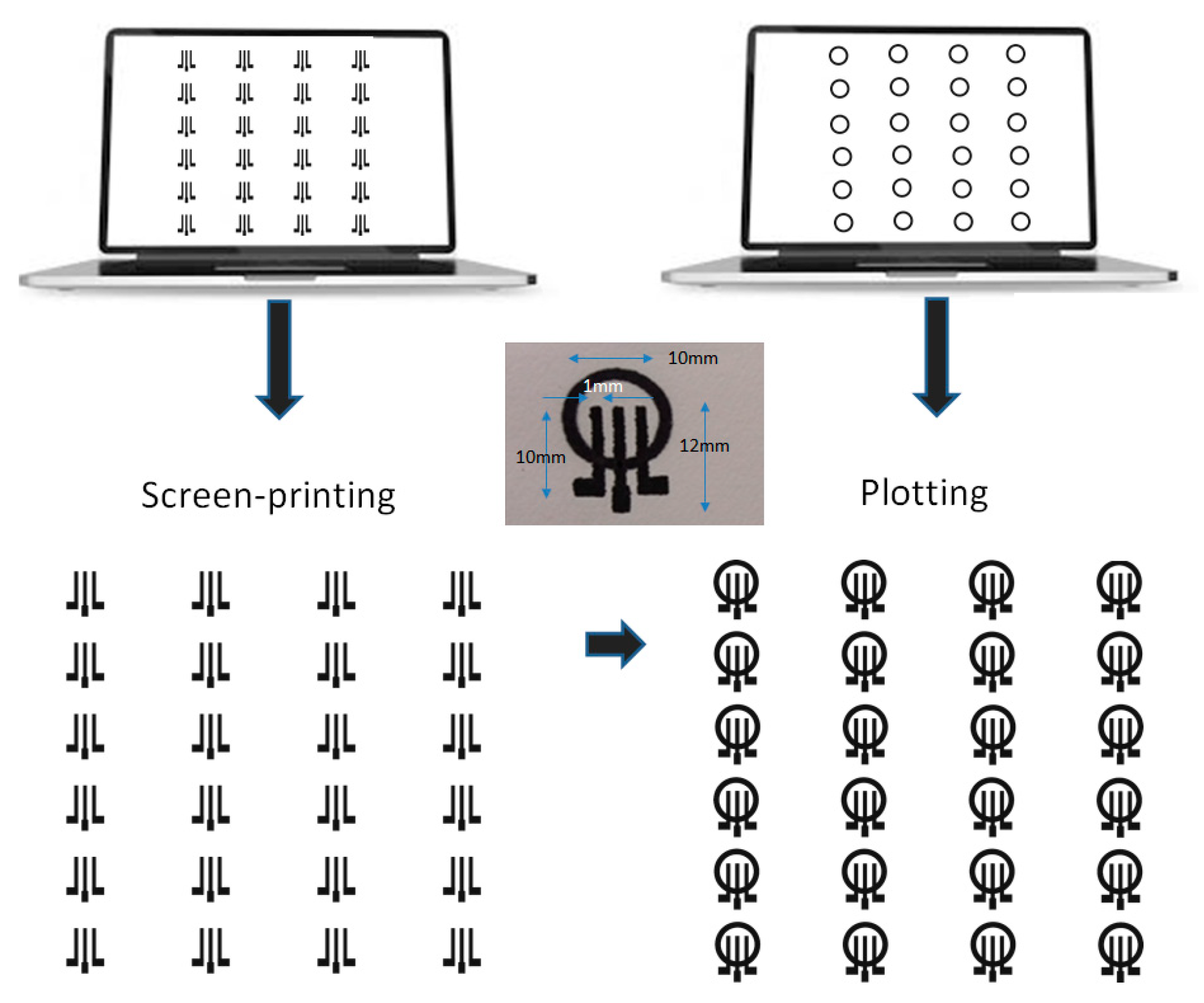Development of a “Green” Paper-Based Voltammetric Platform for the On-Site Assay of Tl(I) †
Abstract
:1. Introduction
2. Experimental
2.1. Reagents and Materials
2.2. Instrumentation
2.3. ePAD Fabrication
2.4. Experimental Procedure
3. Results and Discussion
Author Contributions
Funding
Institutional Review Board Statement
Informed Consent Statement
Data Availability Statement
Conflicts of Interest
References
- Genchi, G.; Carocci, A.; Lauria, G.; Sinicropi, M.S.; Catalano, A. Thallium Use, Toxicity, and Detoxification Therapy: An Overview. Appl. Sci. 2021, 11, 8322. [Google Scholar] [CrossRef]
- Karbowska, B. Presence of thallium in the environment: Sources of contaminations, distribution and monitoring methods. Environ. Monit. Assess. 2016, 188, 640. [Google Scholar] [CrossRef]
- Economou, A.; Kokkinos, C. Advances in Stripping Analysis of Metals. In Electrochemical Strategies in Detection Science; Arrigan, D.W.M., Ed.; The Royal Society of Chemistry: London, UK, 2016; Volume 6, pp. 1–18. [Google Scholar]
- Kokkinos, C.; Economou, A.; Raptis, I.; Speliotis, T. Determination of trace Tl(I) by anodic stripping voltammetry on novel disposable microfabricated bismuth-film sensors. Electroanalysis 2010, 22, 2359–2365. [Google Scholar] [CrossRef]
- Bobrowski, A.; Putek, M.; Zarebski, J. Antimony Film Electrode Prepared In Situ in Hydrogen Potassium Tartrate in Anodic Stripping Voltammetric Trace Detection of Cd(II), Pb(II), Zn(II), Tl(I), In(III) and Cu(II). Electroanalysis 2012, 24, 1071–1078. [Google Scholar] [CrossRef]
- Czop, E.; Economou, A.; Bobrowski, A. A study of in situ plated tin-film electrodes for the determination of trace metals by means of square-wave anodic stripping voltammetry. Electrochim. Acta 2011, 56, 2206–2212. [Google Scholar] [CrossRef]
- Tribhuwan Singh, A.; Lantigua, D.; Meka, A.; Taing, S.; Pandher, M.; Camci-Unal, G. Paper-Based Sensors: Emerging Themes and Applications. Sensors 2018, 18, 2838. [Google Scholar] [CrossRef] [PubMed]
- Ozer, T.; McMahon, C.; Henry, C.S. Advances in Paper-Based Analytical Devices. Annu. Rev. Anal. Chem. 2020, 13, 85–109. [Google Scholar] [CrossRef] [PubMed]
- Noviana, E.; McCord, C.P.; Clark, K.M.; Jang, I.; Henry, C.S. Electrochemical paper-based devices: Sensing approaches and progress toward practical applications. Lab Chip 2020, 20, 9–34. [Google Scholar] [CrossRef] [PubMed]
- Soulis, D.; Pagkali, V.; Kokkinos, C.; Economou, A. Plot-on-demand integrated paper-based sensors for drop-volume voltammetric monitoring of Pb(II) and Cd(II) using a bismuth nanoparticle-modified electrode. Microchim. Acta 2022, 189, 240. [Google Scholar] [CrossRef] [PubMed]
- Costa-Rama, E.; Fernández-Abedul, M.T. Paper-Based Screen-Printed Electrodes: A New Generation of Low-Cost Electroanalytical Platforms. Biosensors 2021, 11, 51. [Google Scholar] [CrossRef] [PubMed]
- Pagkali, V.; Stavra, E.; Soulis, D.; Economou, A. Development of a High-Throughput Low-Cost Approach for Fabricating Fully Drawn Paper-Based Analytical Devices Using Commercial Writing Tools. Chemosensors 2021, 9, 178. [Google Scholar] [CrossRef]


Disclaimer/Publisher’s Note: The statements, opinions and data contained in all publications are solely those of the individual author(s) and contributor(s) and not of MDPI and/or the editor(s). MDPI and/or the editor(s) disclaim responsibility for any injury to people or property resulting from any ideas, methods, instructions or products referred to in the content. |
© 2023 by the authors. Licensee MDPI, Basel, Switzerland. This article is an open access article distributed under the terms and conditions of the Creative Commons Attribution (CC BY) license (https://creativecommons.org/licenses/by/4.0/).
Share and Cite
Kouseri, K.; Panagiotopoulou, I.; Soulis, D.; Economou, A.; Prodromidis, M.; Kokkinos, C. Development of a “Green” Paper-Based Voltammetric Platform for the On-Site Assay of Tl(I). Eng. Proc. 2023, 48, 6. https://doi.org/10.3390/CSAC2023-14904
Kouseri K, Panagiotopoulou I, Soulis D, Economou A, Prodromidis M, Kokkinos C. Development of a “Green” Paper-Based Voltammetric Platform for the On-Site Assay of Tl(I). Engineering Proceedings. 2023; 48(1):6. https://doi.org/10.3390/CSAC2023-14904
Chicago/Turabian StyleKouseri, Katerina, Irini Panagiotopoulou, Dionysios Soulis, Anastasios Economou, Mamas Prodromidis, and Christos Kokkinos. 2023. "Development of a “Green” Paper-Based Voltammetric Platform for the On-Site Assay of Tl(I)" Engineering Proceedings 48, no. 1: 6. https://doi.org/10.3390/CSAC2023-14904
APA StyleKouseri, K., Panagiotopoulou, I., Soulis, D., Economou, A., Prodromidis, M., & Kokkinos, C. (2023). Development of a “Green” Paper-Based Voltammetric Platform for the On-Site Assay of Tl(I). Engineering Proceedings, 48(1), 6. https://doi.org/10.3390/CSAC2023-14904







